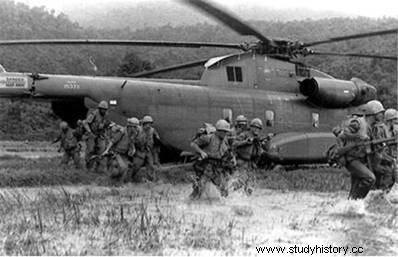
At the end of January 1968, the Communists launched the great Tet offensive (the Lunar New Year). But the air supply allowed the marines, surrounded at Khe Sanh, to hold - although a large third of the dropped supply was recovered by the enemy! The American forces continued to fight against their government to obtain the means of the policy which they were being applied.
Johnson still wanted to decide everything himself:"Let them not drop the slightest bomb without my express permission". The harshest attacks on North Vietnam had not deterred the North Vietnamese, while they cost dearly in pilots. The attacks against the Ho Chi-Minh trail (linking Hanoi to Saigon through the jungle) slowed down the passage of food and ammunition to the battalions fighting in the south, but without stopping them. By 1969, new electronic systems were already in use, including the Igloo White, a very long-range detector. The area of the Ho Chi-Minh trail and other supply routes were riddled with devices such as land sono-buoys, capable of sensing the vibrations of vehicles and transmitting the signal by radio.
Used in conjunction with specially equipped aircraft, these seismic detectors were able to signal the position of each truck on the road. The people sniffer also rendered services, although it lost its effectiveness in rainy weather or because of simple humidity. Transported by helicopter, it measured the ammonia content of the air, caused by any human concentration. But the Communists imagined a parade as simple as it was effective:they filled thousands of jars... with urine, and hung them at random in the jungle, thus misleading the "sniffers"!
Another important development was the radio-controlled craft, beginning in 1970. Some of these radio-controlled craft carried out reconnaissance missions, passing on the information gathered in various ways.
others for attack missions:the BQM-34A was used, for example, to transport Mavericks, Hobos, Shrikes and other machines, to fire them against Fan Song radars, SAM-2 sites and other targets equivalents. A new type of aircraft was in the making from 1970, the "quiet aircraft" for monitoring enemy troops at close range. Planes such as the Q-Star, helicopters such as the "quiet one" (modified version of the OH-6A) made so little noise that they were practically inaudible, even at very close range. They were used to gather intelligence on enemy objectives.
In January 1969, 549,000 American soldiers were still in Vietnam. Most were conscripts who did not stay more than four months in operation, although this type of warfare required above all experience. The main American units were therefore constantly deprived of their experienced personnel. The U.S. Army deployed 4,000 air vehicles, including 3,600 helicopters, slightly more than the total number of helicopters lost in the previous seven years of war.
This force was essential. It was based on a system of staggered support bases, similar to the model installed by the French during the Indochina War (especially on the initiative of Marshal de Lattre de Tassigny, in 1951). These bases were constantly supplied. The French used to send a car convoy every month along Route 19 during the Indochina War. They were often victims of ambushes; the last French column was annihilated. On the same route, the Americans organized every day, in 1970, five supply convoys, but by air. The CH-47Cs, CH-54As and CH-53s carried the heaviest loads, under the protection of armed helicopters. These escorts flew up to thirteen hours a day, and the machines often logged more than 200 flight hours in a month.
